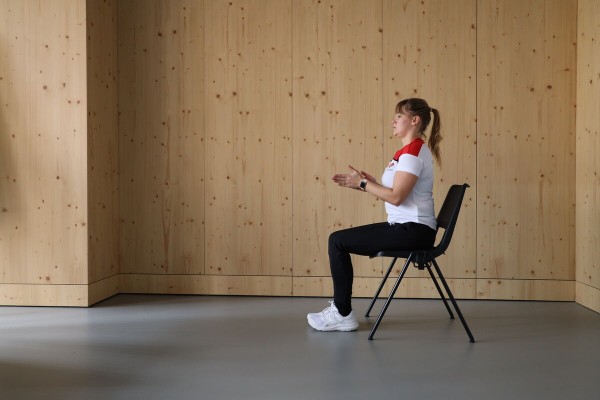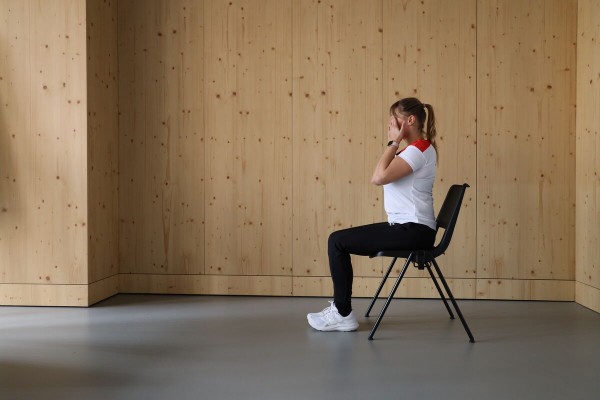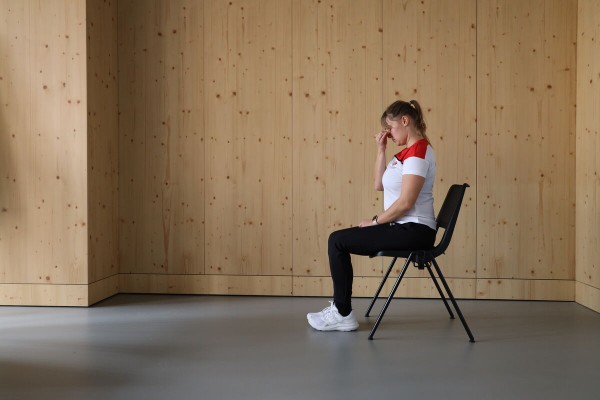Exercises (29)
Breathing exercise: 20 in a row
Relaxation
Individual work
Back position. Perform the following breathing cycle four times without pausing: Four short breaths followed by one long breath. Make sure you breathe through your nose and combine the inhalation with the exhalation (circular rhythm). Take the first four breaths calmly and evenly, inhale deeply into your chest on the fifth breath and exhale in a relaxed manner.
No equipment required (optional in the hall: one soft mat per participant)
Breathing exercise: 5 x 8
Relaxation
Individual work
Lie on your back. Inhale slowly and count to five. Pause briefly and count to eight as you exhale. Perform this breathing cycle five times in succession.
Breathing exercise: from 1 to 20
Relaxation
Individual work
Back position. Slowly count to 20. Breathe out for all odd numbers with your eyes closed and breathe in for the even numbers with your eyes open. From the number 16 onwards, imagine that your eyes are getting heavier and heavier and open them less wide. At 20, keep your eyes closed after exhaling and remain in a resting position for a while (three to five minutes)
.No equipment required (optional in the hall: one soft mat per participant)
Breathing exercise: Centring
Relaxation
Individual work
Breathe consciously while lying comfortably on your back or sitting with your eyes closed. Focus your attention on the centre of your abdomen - approx. one centimetre below your navel. Slowly inhale deeply into the centre of the abdomen (push the abdominal wall outwards) and exhale slowly (let the abdominal wall fall inwards). Two to three minutes in the practice phase, as an application only a few breaths long.
No equipment required (optional in the hall: one soft mat per participant)
Autogenic training: heaviness exercise
Relaxation
Individual work
Autogenic training: The external stimulus (i.e. the formulations) triggers an internal process. This can happen through external or self-suggestions. Don't want anything - don't expect anything - don't do anything, just feel into yourself and let it happen.
How to do it: To get in the mood, take a sitting or lying position in a quiet place, breathe in and out calmly and close your eyes slowly. The trainer or each participant then says the following phrases in their mind:
- "I am completely calm." (3-6x)
- "My right arm is very heavy." (3-6x)
- "I am very calm." (3-6x)
- "My left arm is very heavy." (3-6x)
- "I am very calm." (3-6x)
- "Both legs are very heavy." (3-6x)
To undo, count slowly from 4 to 0 and open your eyes.
Per day:
1 soft mat (small)
Autogenic training: heat exercise
Relaxation
Individual work
Autogenic training: The external stimulus (i.e. the formulations) triggers an internal process. This can happen through external or self-suggestions. Don't want anything - don't expect anything - don't do anything, just feel into yourself and let it happen.
How to do it: To get in the mood, take a sitting or lying position in a quiet place, breathe in and out calmly and close your eyes slowly. The trainer or each participant then says the following phrases in their mind:
- "I am completely calm." (3-6x)
- "My right arm is warm to the touch." (3-6x)
- "I am completely calm." (3-6x)
- "My left arm is warm to the touch." (3-6x)
- "I am completely calm." (3-6x)
- "Both legs are warm to the touch." (3-6x)
Per day:
1 soft mat (small)
Relaxation
Relaxation
Individual work
The participants lie on their backs with their eyes closed (on a soft surface, e.g. a soft mat in the hall or dry grass in the field) and relax to appropriately calm music (or a relaxation story).
Variant:
Instead of calm music, an information CD (teaching exercise: e.g. training methodology) is played, whereby the basic idea of relaxation is somewhat lost.
Per participant:
1 soft mat
Music (quiet)
Relaxation
Relaxation
Individual work



To generate heat, the palms of the hands are rubbed together quickly. Then place the warmed palms over the closed eyes. The pleasant warmth should relax the eye muscles. Alternatively, the thumb and index finger of one hand can be placed on each eye to massage them gently using circular movements.
1 (office) chair
Loosening exercises
Relaxation
Partner work
Groups of 2
The partner performs various loosening exercises by hand on the lying participant (swinging and shaking the limbs and making circular movements with them). Vary the speed and range of movement. Then change roles.
Participants lying on their back:
- Loosen leg left/right (swing/shake)
- Circular movements with leg left/right
- Bend and stretch leg left/right
- Loosen arm left/right in upright, horizontal and vertical position (swing/shake)
Participants lying on their stomach:
- Loosen leg left/right (swing/shake out)
No material required
Loosening exercises
Relaxation
Partner work
Groups of 2
The partner performs various loosening exercises (swinging and shaking the limbs and making circular movements with them) on the lying participant using the aid (e.g. power hose/skipping rope). Vary the speed and range of movement. Then change roles.
Participants lying on their back:
- Loosen leg left/right (swing/shake)
- Circular movements with leg left/right
- Loosen arm left/right in upright, horizontal and vertical position (swing/shake)
Participants lying on their stomach:
- Loosen leg left/right (swing/shake out)
Per group:
1 skipping rope / ribbon
Loosening exercises
Relaxation
Individual work
The participants perform various loosening exercises (swinging and shaking the limbs and performing circular movements with them). Vary the speed and range of movement.
- Leg loosening left/right (swinging/shaking)
- Circular movements with leg left/right
- Bending and stretching leg left/right
- Arm loosening left/right in upright, horizontal and vertical position (swinging/shaking)
No material required
Loosening exercises
Relaxation
Partner work
Stand facing each other in pairs, grasp hands and perform loose pushing and pulling movements. Circular movements can also be integrated in both directions or the arms can be moved up and down alternately.
No material required
Massage
Relaxation
Partner work
Groups of 2
The participants perform massages on their partner using an aid (e.g. tennis ball or throwing object). During the circular movements with the ball, the circumference (small-large) and the pressure (no pressure on joints) are varied.
Participant in supine position, massage by partner of:
- Front thigh muscles
- Abdominal muscles
- Chest muscles
- Arms
Participant in prone position, massage by partner of:
- Calf muscles
- Back thigh muscles
- Buttock muscles
- Back muscles
- Arms
Per group:
1 tennis ball
1 soft mat
Progressive Muskelrelaxation
Relaxation
Individual work
Progressive muscle relaxation: Reducing muscle tension by systematically tensing and relaxing different muscle groups.
The participants spread out in the hall and lie on the floor (or on a small soft mat). At the instructor's command, they consciously tense a predetermined muscle group for 10-15 seconds and then release the tension again. After a 20-30 second break, the exercise is repeated 2-3 times for each muscle group.
Tighten and release the following muscle groups several times:
- Calf muscles left/right
- Thigh muscles left/right
- Buttock muscles
- Belly muscles
- Chest muscles
- Arm muscles (biceps) left/right
- Arm muscles (forearm) left/right
Note: This relaxation method requires good body awareness. Suggestions and templates can be found on the internet, among other places.
Per Tn:
1 soft mat (possibly)
Progressive muscle relaxation: relaxation for the whole body
Relaxation
Individual work
Progressive muscle relaxation: Reducing muscle tension by systematically tensing and relaxing different muscle groups.
How to do it: Lie on your back and just pay attention to your breathing for a few minutes (breathe in and out calmly 20 times). Then tense the whole body as tightly as possible (5 to 7 seconds). Feel the relaxation and muscle sensation for the next 20 seconds or so.
Per day:
1 soft mat (small)
Progressive muscle relaxation: relaxation of extremities and centre
Relaxation
Individual work
Progressive muscle relaxation: Reduce muscle tension by systematically tensing and relaxing different muscle groups.
Lay on your back and just pay attention to your breathing for a few minutes (breathe in and out calmly 20 times). Then tense individual body parts as tightly as possible (5 to 7 seconds). For the next 20 seconds or so, feel the relaxation and muscle sensation.
- Dominant hand and arm ("clench fist and press arm against support");
- Non-dominant hand and arm ("clench fist and press arm against support");
- Head and face ("grimace, squint eyes, wrinkle nose, press head against support");
- Upper body, stomach and buttocks ("consciously tense, clench buttocks tightly");
- Dominant foot and dominant leg ("clench feet slightly, lift whole leg off the floor at the same time");
- Non-dominant foot and leg ("clench feet slightly, lift whole leg off the floor at the same time").
Variant:
Power of imagination. The sequence is the same as the exercise above. However, you only imagine the tension (without performing it).
Per day:
1 soft mat (small)
Self-massage: chest muscles
Relaxation
Individual work
Starting position:
Position the ball next to the armpit and slightly under the collarbone with a block. Grasp the block with both hands by the sides or the notches.
Execution:
Apply pressure to the block (and therefore the ball) with your hand and work the entire pectoral muscle with circular movements. If a point in the chest muscles is particularly painful, the ball can be pressed into this point for several seconds to relieve tension. Then switch sides.
1 massage ball
Self-massage: sole of the foot
Relaxation
Individual work
Starting position:
Place one foot on the ball in a standing position.
Execution:
Place your body weight over the foot and move the ball back and forth on the sole of the foot using circular movements. If a point on the sole of the foot is particularly painful, the ball can be pressed into this point for several seconds to relieve tension. Then switch sides.
1 massage ball
Self-massage: gluteal muscles
Relaxation
Individual work
Starting position:
Sitting, place the ball under one side of the buttocks and support the hands next to the buttocks. Place the leg on the same side over the bent other leg.
Execution:
Move the ball back and forth under the buttocks by bending and stretching the bent leg (circular movements). The hands serve as a support. The pressure is relieved or intensified by slightly lifting the buttocks or pressing against the ball. If a point on the buttocks is felt to be particularly painful, the ball can be pressed into this point for several seconds to relieve tension. Then switch sides.
1 massage ball
Self-massage: Neck muscles
Relaxation
Individual work
Starting position:
Lying on your back, place the ball under your neck.
Execution:
Turn your head slowly to the left and right or make nodding movements. If one point of the neck muscles is particularly painful, the ball can be pressed into this point for several seconds to relieve tension
1 massage ball
Self-massage: upper arm muscles
Relaxation
Individual work
Starting position:
Position yourself sideways to the wall and wedge the ball between your upper arm and the wall (or on your side).
Execution:
Guide the ball along your upper arm by bending and stretching your legs. The intensity can be changed by applying more/less pressure with the upper body. If one point on the upper arm is particularly painful, the ball can be pressed on this point for several seconds to relieve tension. Then switch sides.
1 massage ball
Self-massage: Back muscles
Relaxation
Individual work
Starting position:
Standing, clamp the ball between your back and the wall (next to your spine).
Execution:
Roll the ball up and down your spine by bending and stretching your legs. The massage can be intensified by applying more pressure to the ball and reduced by reducing the pressure. Then perform the massage on the other side of the spine.
1 massage ball
Self-massage: Back muscles
Relaxation
Individual work
Starting position:
Sitting, place the ball in your lower back above the iliac crest and bend your legs slightly. Support your upper body with your arms as you lean backwards.
Execution:
Lean back slightly, lift the buttocks and slowly roll the ball forwards and backwards so that the entire lower back is covered (along the spine, not on the spine!). If one point of the back muscles is particularly painful, the ball can be pressed on this point for several seconds to relieve tension. Then switch sides.
1 massage ball
Self-massage: Shin
Relaxation
Individual work
Starting position:
Place the ball below the knee in a four-footed stance.
Execution:
Lift the tips of your toes off the floor and slowly move your leg forwards and backwards until the entire shin has been rolled. In addition, turn the heels inwards and outwards to cover the entire shin. Then switch sides.
1 massage ball
Self-massage: shoulder girdle/shoulder muscles
Relaxation
Individual work
Starting position:
Position the ball on your back below the shoulder blade. The legs are bent.
Execution:
Push the ball in all directions using the legs and lifting the buttocks. If a point around the shoulder blade is particularly painful, you can press the ball onto this point for several seconds to relieve tension. Move your arm slowly in all directions to intensify the pressure. Then switch sides.
1 massage ball